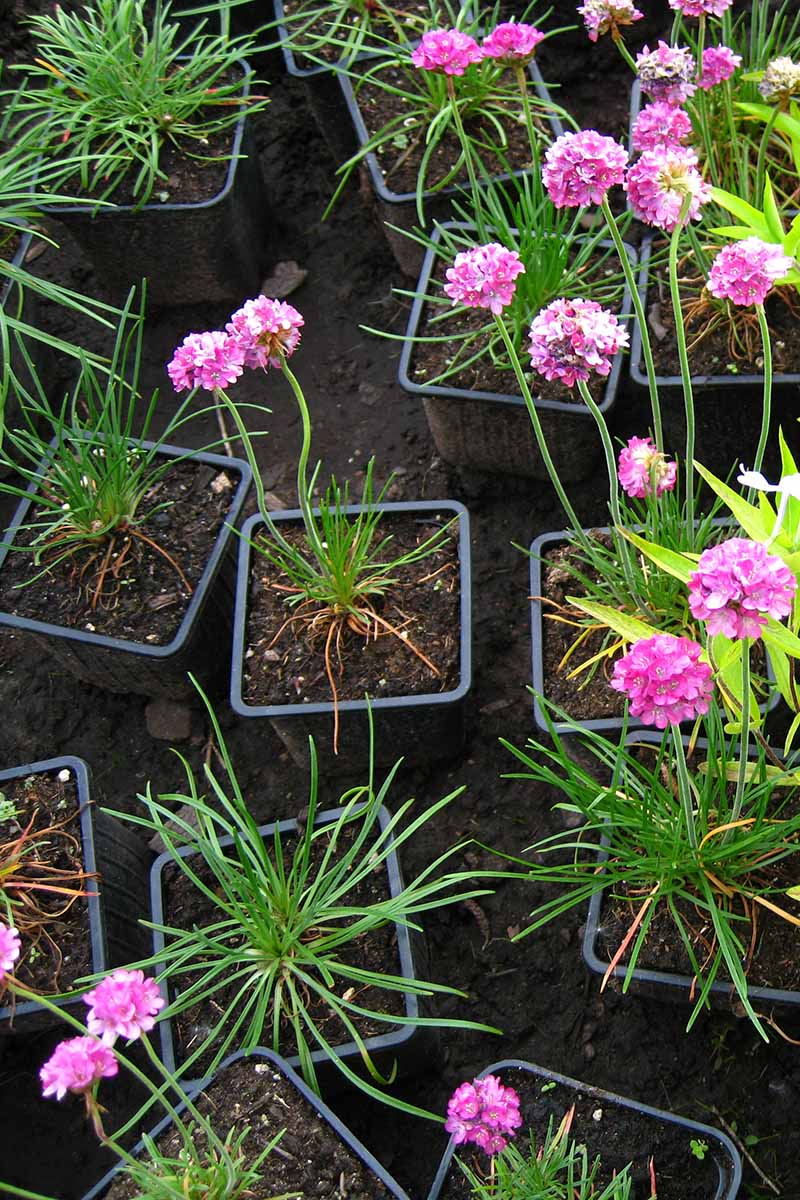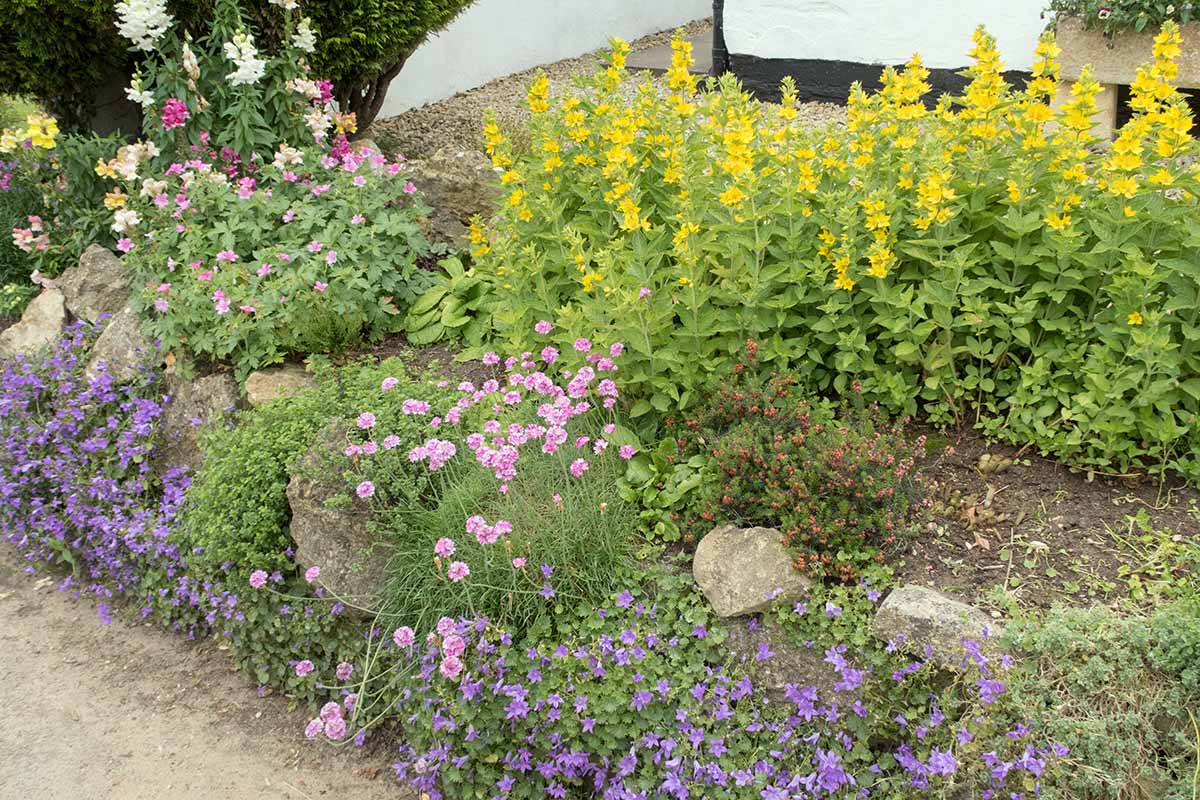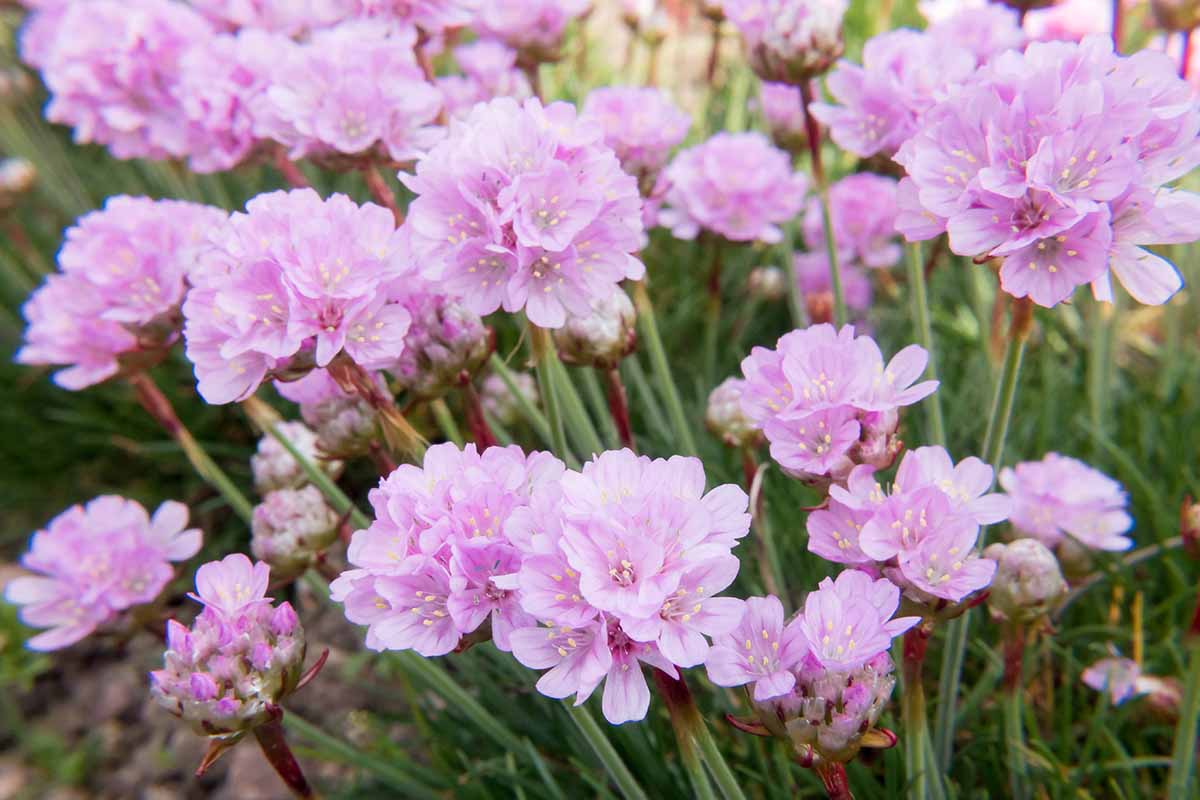
[ad_1]
Armeria maritima
Sea thrift, Ameria maritima, aka sea pink, is a flowering herbaceous perennial for USDA Hardiness Zones 4 to 8.
It is a member of the large Plumbaginaceae family of plants, which includes lavender-blue plumbago commonly found in the Mediterranean.


We link to vendors to help you find relevant products. If you buy from one of our links, we may earn a commission.
A. maritima thrives with minimal water in poor soil and has a high salt tolerance. In the spring, it produces showy flowers in lavender, pink, or white.
Please note that all parts of this plant are toxic due to the species’ ability to absorb and bind heavy metals, such as copper, from the soil.
Read on and learn how to grow and care for sea thrift in your outdoor living space.
Here’s what we’ll cover:
Let’s start with some background.
Cultivation and History
A. maritima is native to seaside locales across coastal Britain, northern Europe, and the North American Pacific Coast.
Upright clumps of flowering sea thrift are commonly found growing on windswept seaward cliffs and coastlines, where the soil is gravelly, well-draining, and saturated with salt. Deep taproots hold them in place.


The foliage is green and grass-like with bare flower stems that sport bobbing, rounded clusters of five-petaled blossoms enclosed in purplish, papery bracts from spring to summer.
This slow-spreading, non-invasive species reaches maximum dimensions of six to 12 inches tall and wide.
There are numerous subspecies, like the pink-flowered California sea pinks, A. maritima subsp. californica, and pink or white A. maritima subsp. sibirica, which is native to Alpine regions and is found growing wild in Colorado and northeastern Utah.
Plants have a high tolerance for drought, poor or rocky soil, heavy metal contamination, salt, and wind.
Sea thrift prefers full sun but tolerates part shade. It can’t tolerate dense, fertile, or moist soil. The crowns, where the stems and roots meet, rot under these conditions.


We strongly caution against consumption because we know that this plant may contain toxic heavy metals.
Historically, it was used by Scottish herbalists to treat conditions ranging from tuberculosis to hangover.
The species enjoyed a brief period of fame between 1937 and 1952 when an engraving of three spherical sea thrift flowers graced the reverse side of a three-pence British coin, aka the thruppenny bit.
The notion of the lowly coin representing thrift is the likely reason the species was chosen.
Let’s talk about how to start a plant.
Sea Thrift Propagation
There are four ways to propagate sea thrift: from seeds, basal cuttings, divisions, and from nursery transplants.


Note that A. maritima has no seed pods. Instead, each blossom bract disperses one individual seed covered in papery chaff.
If you collect seeds from an existing plant, sow them in the fall, or store them in an airtight jar in a cool, dark, dry place to sow the following spring.
From Seed
To start from seed, you’ll need to collect them from a species plant rather than a cultivated variety if you wish to produce a true replica of the parent plant.
You may read otherwise, but seeds do not require any type of treatment prior to sowing.
Sow seeds directly outdoors in the spring after the last spring frost date, when nighttime temperatures are reliably 40°F or above.
Alternatively, start seeds indoors in egg cartons or biodegradable seed starter pots about eight to 10 weeks before the last frost date to get a jump on the growing season.
You can also sow seeds directly outdoors in the ground or containers eight to 10 weeks before the first average frost date.
Press the seeds gently into moistened, gritty, well-draining potting or garden soil with a low nutrient content. They should remain at the soil surface or be barely covered.
Keep the soil moist but not soggy, and seeds sown in pots indoors should be kept in a brightly lit location. Expect sprouts in approximately 21 to 28 days.
Flowers started from straight species seed bloom in the second year. We’ll soon learn that there are cultivated varieties that bloom in the first year.
From Basal Stem Cuttings
Basal cuttings can be taken in spring or summer.
In spring, you can remove the new shoots that grow around the edges of a parent crown.
Here’s how:
Water the plant the day before so the soil is moist.
Reach under a clump of fresh, green foliage and bend it back to expose the shallow roots of the new growth. The edge of the clump should come away easily.
Sever the more mature roots underneath to lift part of the clump away from the ground.
Use your fingers to separate the individual new shoots. Each should have its own small tap root.
Replant as desired.
You can also take basal cuttings during the summer.
Use a clean, sharp knife to slice straight across individual stems at the soil level.
Dip the cut or heel ends into rooting hormone powder.
Work the garden soil to a crumbly consistency. Push the cut ends into the garden soil.
The depth should be just enough for the stems to stand upright when backfilled with soil.
Keep the soil moist but not soggy during the weeks it takes for roots to establish. Foliar growth follows root regeneration and signifies success.
By Division
You can also divide existing clumps of sea thrift before they bloom in early spring or at the end of the season in early fall.
To divide sea thrift clumps:
Water the clump one to two days before you plan to divide so the soil is easy to work.
Use a long-handled shovel to dig down at least a foot and unearth an entire clump. Place your shovel blade just outside the perimeter of the foliage and angle it toward the clump’s center.
Slice straight down through the clump to create multiple sections, each with roots and foliage.
Replant the sections as desired at the same depth and at least six to 12 inches apart.
Transplanting
After all danger of frost has passed and nighttime temperatures are above 40°F, you can transplant your seedlings or nursery starts.
Acclimate them to the outdoors gradually, for a few hours each day, over the course of about a week.
Work your garden soil to a depth of 10 to 12 inches. Do not add any organic amendments. The earth needs to be low in microbial activity and nutrient content.
If you wish to grow sea thrift in containers, use three-gallon pots with a depth of at least nine and a half inches to accommodate the woody tap roots.
Choose a potting soil that is gravelly and nutrient-poor, like this coco peat and perlite product.
This natural blend is airy, loose, and well-draining.
Coco Peat Perlite Potting Mix is available from the Soil Sunrise Store via Amazon in two-, four-, eight-, and 12-quart bags.
Transplant them into the garden or permanent outdoor pots at the same depth as the plants were growing in the starter containers.
The crown, where the stems and roots meet, should be slightly elevated above the soil level to facilitate drainage and inhibit rotting.
For multiple plants, space them six to 12 inches apart. Keep the soil evenly moist but not waterlogged for the first year after planting.
Now, let’s talk about growing.
How to Grow Sea Thrift
Choose a location with full sun. Some shade is tolerable.
The soil should be very lean, with a gravelly, well-draining consistency. The ideal pH is in the 4 to 10 range, meaning it can be acidic, neutral, or alkaline.


Established flora has a high tolerance for drought, salt, and wind. Overwatering and excess ambient humidity are detrimental and may result in pest and pathogen issues.
Once established in a pot or garden bed, plants should only need supplemental water during prolonged dry spells.
Sea thrift requires no fertilizer.
Growing Tips
Cultivation is easy when you remember to:
- Use a nutrient-poor, gritty, well-draining potting or garden soil.
- Do not amend the soil with organic matter or apply fertilizer.
- Allow a container depth of at least 9.5 inches for the long tap roots.
- Provide a full sun location.
- Keep the soil moist during establishment in the first growing season.
- Avoid overly wet conditions.
The final point is the most crucial – ironically, waterlogged conditions are the nemesis of this plant in spite of having “sea” in its name!
Pruning and Maintenance
Clumps spread slowly, gradually increasing their presence in the landscape. You may want to divide them to redirect their path or establish them elsewhere.
Divide them in early spring before flowering or post-season in early fall.


At this time, you can also remove the dead centers of clumps that may have succumbed to rotting from overly wet conditions.
Prune back dead foliage as needed and deadhead spent flower stems during spring flowering to promote sporadic reblooming during the summer.
Alternatively, you can let the flowers run to seed and collect those of species plants to sow in the fall or spring.
Allow the evergreen leaves to remain in place post-bloom.
Sea Thrift Cultivars to Select
If you want to grow the species plant, with its vivid magenta-pink blossoms you can find plants available from Nature Hills Nursery in #1 containers.
Cultivated varieties are also available to home gardeners. Remember, if you intend to collect seeds for propagation, only those from the species plant will grow true.
Alba
A. maritima ‘Alba’ has white flowers and grows to heights of three to six inches with a spread of six to nine inches. It’s hardy in Zones 4 to 8.
‘Alba’ is available from Hirt’s Gardens via Walmart in quart-sized containers.
Splendens
‘Splendens’ is a little more cold hardy than the species plant and is suitable for cultivation in Zones 3 to 8. It reaches a mature height and width of eight to 10 inches.
Bright rose-pink flowers grace the landscape in late spring.
‘Splendens’ is available from Nature Hills Nursery.
False Sea Thrift
In addition, there is a species called false or great sea thrift, A. pseudarmeria.
It has broader leaves, larger bloom clusters, stiffer stems, and a taller stature than A. maritima. Mature specimens are eight to 10 inches tall and wide and will possibly grow taller in fertile soil that causes leggy stems.
‘Ballerina Red’ is a A. pseudameria cultivar suited to Zones 6 to 9. Like A. maritima, it prefers full sun but will tolerate partial shade.
Globular clusters of bright red spring flowers bloom from mid to late spring in the first year.
Ballerina red is exceptionally heat and salt-tolerant. With deadheading, there may be sporadic summer blooms.
‘Ballerina Red’ is available from Nature Hills Nursery.
Managing Pests and Disease
A. maritima is not especially prone to pests or pathogens, but it’s worth keeping an eye out for the following:
Leafhoppers
Leafhoppers are sap-sucking, hopping insects of various colors.
Their feeding causes light-colored speckling and their excretions are a breeding ground for sooty mold. Large infestations can cause leaf yellowing and desiccation.
Treatment with food-grade diatomaceous earth may be effective.
Slugs
Slugs favor overly wet conditions and defoliate flora with their voracious chewing.
If you find slug damage or evidence of their presence, read our guide to learn more about how to deal with them.
Disease
Overly wet conditions, especially with organically-rich, poorly draining soil, may promote the proliferation of fungal conditions like leaf spot, rust, and stem and root rot.
Leaf Spot
Leaf spot disease is caused by a number of different fungal pathogens and appears as brownish spots with a yellowish halo and sometimes visible dark specks in the center.
Leaf drop follows. Removing affected foliage and treating with a fungicide should be effective.
Rust
Rust has similar symptoms, and is also caused by a variety of different fungi. Rust-colored leaf spots become blister-like, spreading and causing leaf drop.
Removing affected leaves may be effective, but many types of rust are fungicide-resistant.
Stem and Root Rot
Rhizoctonia solani, a soil borne fungus, causes stem and root rot. Symptoms include lesions on the stems and foliage near ground level and root decay.
Plants in the seedling stage and those in overly wet soil are most susceptible.
The best approach to this pathogen is to act preventatively by buying high-quality, disease-free seed. If your plants are infected, remove affected parts and sanitize garden tools.
Contact your local agricultural extension for details about which fungicides are currently recommended.
Best Uses for Sea Thrift
Sea thrift is a versatile flower naturally suited to salty coastal beds, borders, and containers.


With a three-gallon pot or larger to accommodate its long tap root, you’ll find it an excellent companion to aubretia coreopsis, geranium, and loosestrife.
Its petite stature and spreading growth habit make sea thrift ideal for edging and mass-planting as a ground cover. Sprawling companions include fleabane, gumweed, stonecrop, and sand verbena.
The showy flower heads and straight, upright stems are desirable in a cutting garden, where the plants attract beneficial bees, beetles, butterflies, flies, and moths.
And finally, A. maritima shines in rock gardens and naturalistic, low-moisture xeriscapes.
Quick Reference Growing Guide
| Plant Type: | Herbaceous perennial | Flower/Foliage Color: | Pink, lavender, white/green |
| Native to: | Coastal Britain, northern Europe, North American Pacific Coast | Tolerance: | Deer, drought, dry/poor/rocky soil, heavy metal contamination, rabbits, salt, wind |
| Hardiness (USDA Zone): | 4-8 | Maintenance: | Moderate |
| Bloom Time: | Spring, sporadic summer with deadheading | Soil Type: | Lean, rocky, sandy |
| Exposure: | Full sun to part shade | Soil pH: | 4.0-10.0 |
| Spacing: | 6-12 inches | Soil Drainage: | Well-draining |
| Planting Depth: | Surface sow (seeds), same depth as original container (transplants) | Attracts: | Bees, beetles, butterflies, flies, moths |
| Height: | 6-12 inches | Companion Planting: | Aubretia, columbine, coreopsis, dianthus, fleabane, geranium, gumweed, loosestrife, sand verbena, and stonecrop |
| Spread: | 6-12 inches | Uses: | Coastal beds and borders, containers, cutting gardens, edging, ground cover, mass planting, rock gardens, xeriscapes |
| Growth Rate: | Slow | Family: | Plumbaginaceae |
| Water Needs: | Low | Genus: | Armeria |
| Common Pests and Diseases: | Leafhoppers, slugs; leaf spot, rust, stem and root rot | Species: | Maritima |
A Seasoned Seaside Beauty
Don’t be deceived by sea thrift’s quaintly bobbing blooms. Beneath their dainty appearance is a tough plant that is accustomed to battering winds, nutrient-poor soil, and sea spray.


A. maritima is a star in the home garden because it is not prone to pests or diseases, spreads non-aggressively, and is ideal for a water-wise landscape.
Avoid excess moisture, provide excellent drainage, and skip the fertilizer to enjoy years of perky springtime blooms.
Do you grow sea thrift in your outdoor living space? Please share your thoughts in the comments section below.
If you found this article helpful and want to read about more flowers for your garden, we recommend the following:
[ad_2]












